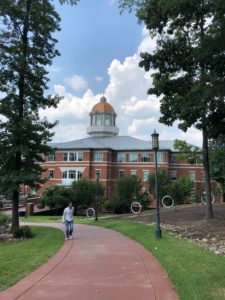Spotlight: Campus Success Story

Photo credit: Gage Paine
This summer I had the opportunity to work with the Title IX Office at the University of North Carolina at Charlotte. This office had an interesting design that creates some challenges. There are five staff members in the office: the director, two investigators, and two case managers. They work with student, faculty, and staff concerns. The case managers are not advocates. Their job is to support any person who is working with the office, whether complainant or respondent. It’s not surprising that the tasks, metrics, and definitions for success are very different for investigators and case managers.
The Director asked me to design a day-long retreat that would engage everyone in shared activities and tasks. I suggested we talk about vision and mission and use those discussions to help team members identify the common threads that link their various types of work. The director agreed to this idea as a team-building activity. She also wanted us to use this process as a foundation for a purpose-driven conversation for beginning the development of an effective assessment plan.
Mission Discussion
The mission statement for the Title IX Office serves a necessary notice function for the campus, but there’s no reason why it can’t be inspirational as well. As I’ve said in previous blog posts, I like starting with mission statements. I gave them my usual guidelines – use these three questions, 25-word limit – split them into two groups (a pair and a trio) and put them to work. Next, each group shared their drafts and we identified themes and powerful words and sent everyone back for round two. The result was a clear statement of the values and purpose of their work. And it encompassed both investigation and case management.
What it didn’t do was provide sufficient notice to the campus. Which led to a few edits after the fact to provide some clarity for external audiences. (Which means it’s a bit longer than 25 words, but that’s a guideline, not a rule.) Here’s their new mission statement.
We are committed to supporting all members of the university community by providing equitable services and resources including education, investigations, and care coordination in relation to sex-based discrimination, sexual harassment, and sexual and interpersonal misconduct.
Vision Discussion
We remixed the groups and used the same process for the vision statement. The result was even more exciting. Both groups reached beyond the constraints of their daily tasks and imagined their work leading to a transformed campus community. After they had completed the mission statement, there had been a lot of energy in the room. There was less so after the vision statement and the director asked what that was about. People responded that all was good. I think the silence was due to the power of the vision and of the idea that they could help create the campus culture they had just described.
To develop a culture which embraces a sense of personal responsibility and accountability where members feel empowered to reclaim their community by opposing acts of violence and discrimination.
Approved
The Vice Chancellor and General Counsel thought the vision statement was great and it went up on the website immediately. He also liked the basic mission statement, though he asked for a couple of additions. It should be up on the website shortly.
Wrap-up
There are many reasons why I think it is worth spending time on mission and vision. Creating these statements is a team-building exercise. It helps staff find meaning and purpose in their work. It also supports developing an assessment plan that matters rather than an assessment plan that is merely a check-off on a list. Mission and vision statements are not fluff work. It’s leadership work for teams. It’s creative work. Done well, it makes a difference for people and organizations. Congratulations, and thank you, to the staff of the Title IX Office at the University of North Carolina at Charlotte!
